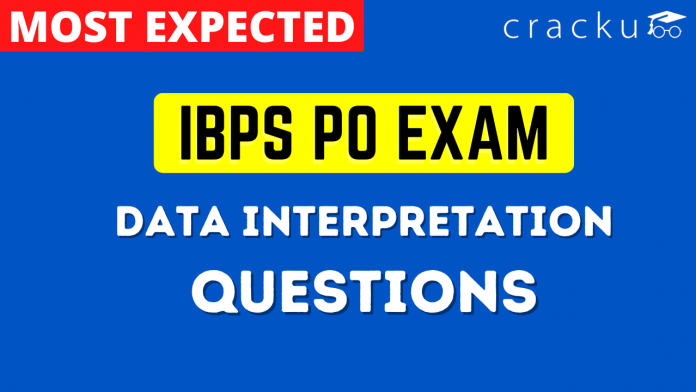IBPS PO Prelims Data Interpretation Questions PDF [Most Important]
One Data Interpretation is one of the key topics in the IBPS PO Prelims exam. Here you can download free Data Interpretation questions PDF with answers for IBPS PO Prelims 2022 by Cracku. These questions will help you to practice and solve the Data Interpretation questions in the IBPS PO exams. Utilize this best PDF practice set which includes the answers in detail. Click on the below link to download the Data Interpretation Usage MCQ questions PDF for IBPS PO Prelims 2022 for Free.
Download Data Interpretation Questions for IBPS PO Prelims
Download IBPS PO Previous Papers
Question 1: The bar graph given below shows the sales of Newspapers (in lakh number) from six branches of a Media Publication Company during two consecutive years 2017 and 2018.
(Note: The data shown belowis only for mathematical exercise. They do not representthe actual figures).
Figure
Total Sales of U for both the years is what percent (correct to one place of decimal) of the combined Sales of the branches Q and R for 2017 and 2018?
a) 48.6%
b) 67.1%
c) 44.4%
d) 41.0%
1) Answer (C)
Question 2: The pie graph shows the distribution of employees working in five departments A, B, C, D and E of a company.
Total number of employees = 9000
Figure
If the number of employees working in department A is x and the total number of employees working in departments C and E is y, then the value of y – 2x is:
a) 725
b) 850
c) 1000
d) 915
2) Answer (D)
Question 3: Bar graph shows the number of males and females in five organizations A, B, C, D and E.
Figure
What is the ratio of number of males working in organizations C, D and E taken together to that of females working in organizations A, B and C taken together?
a) 10:11
b) 49:46
c) 11:10
d) 46:49
3) Answer (A)
Question 4: The data given in the table shows the number of boys and girls enrolled in three different streams in a school over 5 years.
Figure
What is the ratio of the total number of boys in the year 2014 to the total number of girls in the year 2020?
a) 58 : 57
b) 55 : 57
c) 58 : 53
d) 1 : 1
4) Answer (A)
Question 5: The following bar graph showsthe amount(in Lakh Rs.) invested by a Companyin purchasing rawmaterial over the years and the values (in Lakh Rs.) of finished goods sold by the Company overthe years.
Figure
The ratio of total amount invested for purchasing raw material from 2013 to 2015 to the total sales of finished goods in 2014, 2016 and 2017 is:
a) 27 : 56
b) 56 : 27
c) 64 : 37
d) 37 : 64
5) Answer (D)
Instructions
Study the following table and answer the question:
Number of students enrolled for Vocational Courses (VC) in five institutes – A, B, C, D & E.
Figure
Question 6: The total number of students enrolled for VC in institutes A, B and D in 2015 is what percent more than the total number of students enrolled in institutes C and E in 2018? (correct to one decimal point)
a) 28.2
b) 36.8
c) 35.7
d) 39.3
6) Answer (D)
Question 7: What is the sum of the average numberofstudents enrolled for VC in institute B in 2014, 2015 and 2017 and the average number of students enrolled in institute E in 2013 and 2018?
a) 250
b) 265
c) 260
d) 255
7) Answer (C)
Question 8: The given histogram represents the marks obtained by 128 students. Read the graph and answerthe question that follows.
Figure
What percent of students got marks less than 60?
a) 67.5%
b) 72.5%
c) 75%
d) 62.5%
8) Answer (D)
Instructions
Study the following information carefully and answer the questions.

Note:: Total marks obtained by a girl = Marks obtained by that girl in Reasoning + Marks obtained by that girl in Quant + Marks obtained by that girl in English.
Question 9: If the marks obtained by Ravina in Reasoning is 7.69% more than the marks obtained by Dipshikha in Reasoning and the total marks obtained by Chinky is the same as Ravina, then find out the sum of marks obtained by Ravina in Quant and English together.
a) 184
b) 196
c) 188
d) 192
9) Answer (A)
Solution:



If the marks obtained by Ravina in Reasoning is 7.69% more than the marks obtained by Dipshikha in Reasoning.
Marks obtained by Ravina in Reasoning = (14/13) of 65 = 70
Total marks obtained by Chinky is the same as Ravina.
Total marks obtained by Chinky = Total marks obtained by Ravina = 254
Sum of marks obtained by Ravina in Quant and English together = 254-70
= 184
Hence, option a is the correct answer.
Question 10: If the total marks obtained by Savita is one fifth the sum of the marks obtained by all the four girls together, then find the total marks obtained by Savita.
a) 187
b) 193
c) 195
d) 189
10) Answer (D)
Solution:



If the total marks obtained by Savita is one fifth the sum of the marks obtained by all the four girls together.
Total marks obtained by Savita = ⅕ of sum of the marks obtained by all the four girls together.
= ⅕ of (232+239+254+220)
= ⅕ of 945
= 189
Hence, option d is the correct answer.
Question 11: What is the difference between the total marks obtained by all the four girls in Reasoning and the total marks obtained by all the four girls in Quant?
a) 7
b) 6
c) 8
d) 9
11) Answer (B)
Solution:



Difference = (85+66+94+65) – (78+81+73+72)
= 310-304
= 6
Hence, option b is the correct answer.
Question 12: Find out the sum of the marks obtained by all the four girls in English.
a) 223
b) 327
c) 331
d) 339
12) Answer (C)
Solution:



Sum of the marks obtained by all the four girls in English = 69+92+87+83
= 331
Hence, option c is the correct answer.
Question 13: The following pie chart shows the percentage distribution of expenditure on different expenses and savings out of the total monthly salary of a person:

If the difference between the monthly amount spent on Food and Transport is Rs.280, then find the total monthly amount spent on Rent and Food together.
a) Rs.4800
b) Rs.6400
c) Rs.5600
d) Rs.8400
13) Answer (D)
Solution:
Let his monthly salary be Rs.x.
Given, 24% of x – 22% of x = 280
2% of x = 280
x = $\dfrac{280\times100}{2} = 14000$.
Hence, The total amount spent on rent and food together = (36+24)% of 14000 = 60% of 14000 = Rs.8400.
Question 14: The following bar graph shows the total population of five villages (in thousands) and the number of females out of them:

What is the ratio between the number of males in Villages P and Q together and the number of males in Villages S and T together respectively?
a) 17:13
b) 19:17
c) 19:13
d) 13:17
14) Answer (C)
Solution:
The required ratio = (36000-16000+42000-24000) : (24000-18000+40000-20000) = 38000 : 26000 = 19:13
Question 15: The following bar graph shows the number of tickets booked to four cities and the percentage of tickets cancelled out of them:

In which of the following cities, the number of tickets which were not cancelled is the highest?
a) Hyderabad
b) Delhi
c) Lucknow
d) Mumbai
15) Answer (B)
Solution:
Number of tickets not cancelled to Hyderabad = (100-40)% of 480 = 60% of 480 = 288.
Number of tickets not cancelled to Delhi = (100-25)% of 560 = 75% of 560 = 420.
Number of tickets not cancelled to Mumbai = (100-35)% of 320 = 65% of 320 = 208.
Number of tickets not cancelled to Lucknow = (100-50)% of 360 = 50% of 360 = 180.
Here, We can say that the number of tickets not cancelled to Delhi is the highest.
Question 16: The following bar graph shows the number of boys and girls in five classes of a school:

What is the difference between the total number of students (boys+girls) in Class VI and the number of boys in Class IX and X together?
a) 8
b) 6
c) 4
d) 2
16) Answer (B)
Solution:
Total number of students in Class VI = 42+38 = 80.
Number of boys in Class IX and X together = 32+54 = 86.
Hence, The required difference = 86 – 80 = 6.
Instructions
Read the following instructions carefully and answer the questions.
In a class test, five students Rohit, Rahul, Prakash, Pranav, and Ajay scored different marks in Mathematics in degrees.

Question 17: What percentage of marks have been obtained by Pranav in the given subject?
a) 80%
b) 75%
c) 60%
d) Can’t be determined
17) Answer (D)
Solution:
As we don’t know the maximum marks of the subject and the value of 75° so we are not able to calculate the percentage of marks of Pranav in the given subject.
Question 18: By how much percent the marks obtained by Ajay is more than the marks obtained by Prakash?
a) 25%
b) 20%
c) 30%
d) Can’t be determined
18) Answer (A)
Solution:
The marks obtained by Ajay and Prakash is 75° and 60° respectively.
Percentage of marks of Ajay more than Prakash
= (75-60)/60
= 15/60 = 25%
Question 19: What could be the marks obtained by Rahul, if the marks obtained by Rohit is 140.
a) 150
b) 160
c) 175
d) None of the above
19) Answer (B)
Solution:
From the pie-chart, we get the marks obtained by Rohit in degrees is 70 which is equal to the given 140 marks.
So, 70° = 140
1° = 2
So, the marks obtained by the Rahul in degree is 80° i.e. 80 x 2 = 160.
Question 20: What is the respective ratio between the marks obtained by Prakash and Pranav in Mathematics?
a) 5:4
b) 10:13
c) 4:5
d) Can’t be determined
20) Answer (C)
Solution:
From the pie-chart, we have the marks obtained by Prakash and Pranav to be 60°and 75°.
So, the ratio between them = 60° of the maximum marks:75° of the maximum marks = 4:5



![SBI PO Puzzles Questions PDF [Most Important] _ Puzzles Questions](https://cracku.in/blog/wp-content/uploads/2022/10/Puzzles-Questions--218x150.png)

